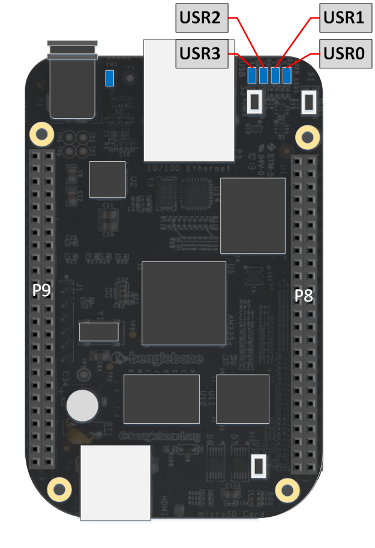Flash BeagleBone Black LED in Response to Input
This example shows how to flash the onboard LED when you press a button that is connected to a GPIO pin.
Caution
Excessive voltage and current can damage the BeagleBone® Black hardware. Observe the manufacturer precautions for handling the
BeagleBone Black hardware and connecting it to other devices. For more information, see
the local copy of the BeagleBone drivers and documentation in the BeagleBone Black Getting
Started folder on your host computer, or Getting Started with BeagleBone
Black.
Using a breadboard, set up the following circuit:
Connect one of the +3.3V pins on the GPIO header to a button.
Connect pin 23 on the GPIO header to a 220 or 330 Ω resistor.
Connect the unconnected ends of the button and resistor to each other.
Use the
showLEDsfunction to show an illustration that identifies each pin.The figure shows the output of a call to
showLEDs.
Run the code and press the button. The button closes the circuit between the +3.3V pin and pin 23. When
readDigitalPindetects the raised voltage,buttonPressedbecomestrue, andwriteLEDtoggles the LED on and off ten times.for ii = 1:100 buttonPressed = readDigitalPin(bbb,'P9_12') if buttonPressed for jj = 1:10 writeLED(bbb,'usr0',1) pause(0.05) writeLED(bbb,'usr0',0) pause(0.05) end end pause(0.1) end
To restore LED 'usr0' to its default, which is to indicate
Linux® kernel activity, restart the BeagleBone Black hardware.